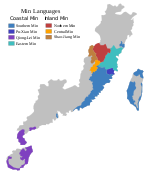| Gutian | |
|---|---|
| Kŭ-chèng-uâ / 古田話 | |
| Native to | Southern China, Malaysia |
| Region | Gutian, Ningde, Fujian; Sibu, Sarawak; Sitiawan, Manjung, Perak |
| Language family | Sino-Tibetan |
| Early forms | Proto-Sino-Tibetan |
| Language codes | |
| ISO 639-3 | – |
| Glottolog | None |
| Linguasphere | 79-AAA-ich |
| This article contains IPA phonetic symbols. Without proper rendering support, you may see question marks, boxes, or other symbols instead of Unicode characters. For an introductory guide on IPA symbols, see Help:IPA. | |
The Gutian dialect (Eastern Min: 古田話) is a dialect of Eastern Min spoken in Gutian, Ningde in northeastern Fujian province, China.
Phonology
The Gutian dialect has 15 initials, 52 rimes and 7 tones.
Initials
| Bilabial | Alveolar | Lateral | Velar | Glottal | ||
|---|---|---|---|---|---|---|
| Stop | Tenuis voiceless | p | t | k | ʔ | |
| Aspirated voiceless | pʰ | tʰ | kʰ | |||
| Nasal | m | n | ŋ | |||
| Fricative | Voiceless | s | h | |||
| voiced | β | ʒ | ||||
| Affricate | Tenuis voiceless | ts | ||||
| Aspirated voiceless | tsʰ | |||||
| Approximant | l | |||||
Rimes
| a 嘉 | ɛ 西 | œ 初 | o 歌 |
| i 之 | u 孤 | y 須 | |
| ai 開 | oi 催 | au 郊 | ɛu 抖 |
| ia 遮 | ie 批 | iu 秋 | iau 燒 |
| ua 花 | uo 過 | uai 歪 | ui 輝 |
| uɔi 杯 | yø 橋 | ||
| aɳ 山 | iɳ 賓 | uɳ 春 | yŋ 銀 |
| iaŋ 聲 | ieŋ 天 | uaŋ 歡 | uoŋ 元 |
| yøŋ 香 | eiŋ 燈 | ouŋ 郎 | øyŋ 東 |
| ak 答 | ik 必 | uk 不 | yk 竹 |
| iak 揭 | iek 哲 | uak 撥 | uok 拙 |
| yøk 箬 | eik 八 | ouk 駁 | øyk 北 |
| aʔ 拍 | œʔ 嗝 | oʔ 桌 | iaʔ 壁 |
| uaʔ 劃 | uoʔ 剝 | yøʔ 藥 |
Tones
| No. | 1 | 2 | 3 | 4 | 5 | 6 | 7 |
|---|---|---|---|---|---|---|---|
| Tone name | dark level 陰平 |
light level 陽平 |
rising 上聲 |
dark departing 陰去 |
light departing 陽去 |
dark entering 陰入 |
light entering 陽入 |
| Tone contour | ˥ (55) | ˧ (33) | ˦˨ (42) | ˨˩ (21) | ˧˨˦ (324) | ˨ (2) | ˥ (5) |
Initial assimilation
The two-syllable initial assimilation rules are shown in the table below:
| The Coda of the Former Syllable | The Initial Assimilation of the Latter Syllable |
|---|---|
| Null coda or /-ʔ/ |
|
| /-ŋ/ |
|
| /-k̚/ | All initials remain unchanged. |
Tone sandhi
The two-syllable tonal sandhi rules are shown in the table below (the rows give the first syllable's original citation tone, while the columns give the citation tone of the second syllable):
| dark level 55 |
light level 33 |
rising 42 |
dark departing 21 |
light departing 324 |
dark entering 2 |
light entering 5 | |
| dark level 55 |
21+55 | 21+33 | 21+42 | 24+21 | 24+544 | 24+2 | 21+5 |
| light level 33 |
21+42 | 21+21 | 21+324 | 21+2 | |||
| rising 42 |
21+55 | 21+24 | 21+42 | 24+21 | 24+544 | 24+2 | 21+5 |
| dark departing 21 |
33+55 | 33+544 | 33+53 | 24+21 | 55+33 | 55+2 | 33+5 |
| light departing 324 |
55+55 | 544+33 | 544+42 | 42+21 | 544+21 | 42+2 | 55+5 |
| dark entering 2 |
33+55 | 33+55 | 33+53 | 55+21 | 55+33 | 55+2 | 55+5 |
| light entering 5 |
33+55 | 21+33 | 21+42 | 21+21 | 21+324 | 21+2 | 33+5 |
Notes
- Min is believed to have split from Old Chinese, rather than Middle Chinese like other varieties of Chinese.
References
- Mei, Tsu-lin (1970), "Tones and prosody in Middle Chinese and the origin of the rising tone", Harvard Journal of Asiatic Studies, 30: 86–110, doi:10.2307/2718766, JSTOR 2718766
- Pulleyblank, Edwin G. (1984), Middle Chinese: A study in Historical Phonology, Vancouver: University of British Columbia Press, p. 3, ISBN 978-0-7748-0192-8
- Hammarström, Harald; Forkel, Robert; Haspelmath, Martin; Bank, Sebastian (2023-07-10). "Glottolog 4.8 - Min". Glottolog. Leipzig: Max Planck Institute for Evolutionary Anthropology. doi:10.5281/zenodo.7398962. Archived from the original on 2023-10-13. Retrieved 2023-10-13.
- Compilation Commission of Chorography of Gutian County 古田县地方志编纂委员会 (1997). Gu tian xian zhi 古田县志 ["Chorography of Gutian County"]. Vol. 32. Beijing: Zhonghua Book Company. ISBN 7-101-01663-4..
| Min Chinese | ||||||||||||||||||||||||||||||||||
|---|---|---|---|---|---|---|---|---|---|---|---|---|---|---|---|---|---|---|---|---|---|---|---|---|---|---|---|---|---|---|---|---|---|---|
| ||||||||||||||||||||||||||||||||||
| ||||||||||||||||||||||||||||||||||
| ||||||||||||||||||||||||||||||||||
